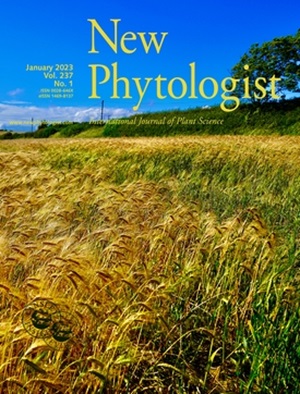An activity-based sensing fluorogenic probe for monitoring O-methyltransferase in plants
IF 8.3
1区 生物学
Q1 PLANT SCIENCES
引用次数: 0
Abstract
- Activity-based sensing probes are powerful tools for monitoring enzymatic activities in complex biological samples such as cellular and live animals; however, their application in plants remains challenging.
- Herein, fourteen activity-based fluorescent probes were assayed against Arabidopsis O-methyltransferases (AtOMTs). One probe, 3-BTD, displayed a high selectivity, reactivity, and fluorescence response toward AtOMTs especially the isoform AtCCoAOMT. We further characterized the features of this probe and explored whether it could be used to detect OMT activities in living plant cells.
- Our results show that 3-BTD can be used to visualize OMT activity in Arabidopsis, and no fluorescent signal was observed in the comt/ccoaomt double mutant, indicating that it has good specificity. Interestingly, in contrast to the observation that AtCCoAOMT-YFP accumulated in both cytoplasm and nucleus, OMT enzymatic activity tracked by 3-BTD probe was found only in the cytoplasm. This underscores the importance of activity-based sensing in studying protein function. Moreover, 3-BTD can be successfully applied in OMT visualization of different plants.
- This study indicates that 3-BTD can serve as a potential probe for in situ monitoring the real activity of OMT in multiple plants and provides a strategy for visualizing the activity of other enzymes in plants.
用于监测植物中 O-甲基转移酶的基于活性的荧光探针。
基于活性的传感探针是监测复杂生物样本(如细胞和活体动物)中酶活性的有力工具;然而,它们在植物中的应用仍然具有挑战性。本文针对拟南芥 O-甲基转移酶(AtOMTs)检测了 14 种基于活性的荧光探针。其中一种探针 3-BTD 对拟南芥 O-甲基转移酶(尤其是同工酶 AtCCoAOMT)具有高度的选择性、反应性和荧光响应。我们进一步确定了该探针的特征,并探讨了它是否可用于检测活体植物细胞中的 OMT 活性。我们的结果表明,3-BTD 可用于检测拟南芥中的 OMT 活性,在 comt/ccoaomt 双突变体中未观察到荧光信号,这表明它具有良好的特异性。有趣的是,与 AtCCoAOMT-YFP 同时在细胞质和细胞核中积累的观察结果不同,用 3-BTD 探针追踪的 OMT 酶活性只在细胞质中发现。这突出了基于活性的传感在研究蛋白质功能方面的重要性。此外,3-BTD 还可成功应用于不同植物的 OMT 可视化研究。这项研究表明,3-BTD 可以作为一种潜在的探针,用于原位监测多种植物中 OMT 的真实活性,并为植物中其他酶的活性可视化提供了一种策略。
本文章由计算机程序翻译,如有差异,请以英文原文为准。
求助全文
约1分钟内获得全文
求助全文
来源期刊

New Phytologist
生物-植物科学
自引率
5.30%
发文量
728
期刊介绍:
New Phytologist is an international electronic journal published 24 times a year. It is owned by the New Phytologist Foundation, a non-profit-making charitable organization dedicated to promoting plant science. The journal publishes excellent, novel, rigorous, and timely research and scholarship in plant science and its applications. The articles cover topics in five sections: Physiology & Development, Environment, Interaction, Evolution, and Transformative Plant Biotechnology. These sections encompass intracellular processes, global environmental change, and encourage cross-disciplinary approaches. The journal recognizes the use of techniques from molecular and cell biology, functional genomics, modeling, and system-based approaches in plant science. Abstracting and Indexing Information for New Phytologist includes Academic Search, AgBiotech News & Information, Agroforestry Abstracts, Biochemistry & Biophysics Citation Index, Botanical Pesticides, CAB Abstracts®, Environment Index, Global Health, and Plant Breeding Abstracts, and others.
 求助内容:
求助内容: 应助结果提醒方式:
应助结果提醒方式:


